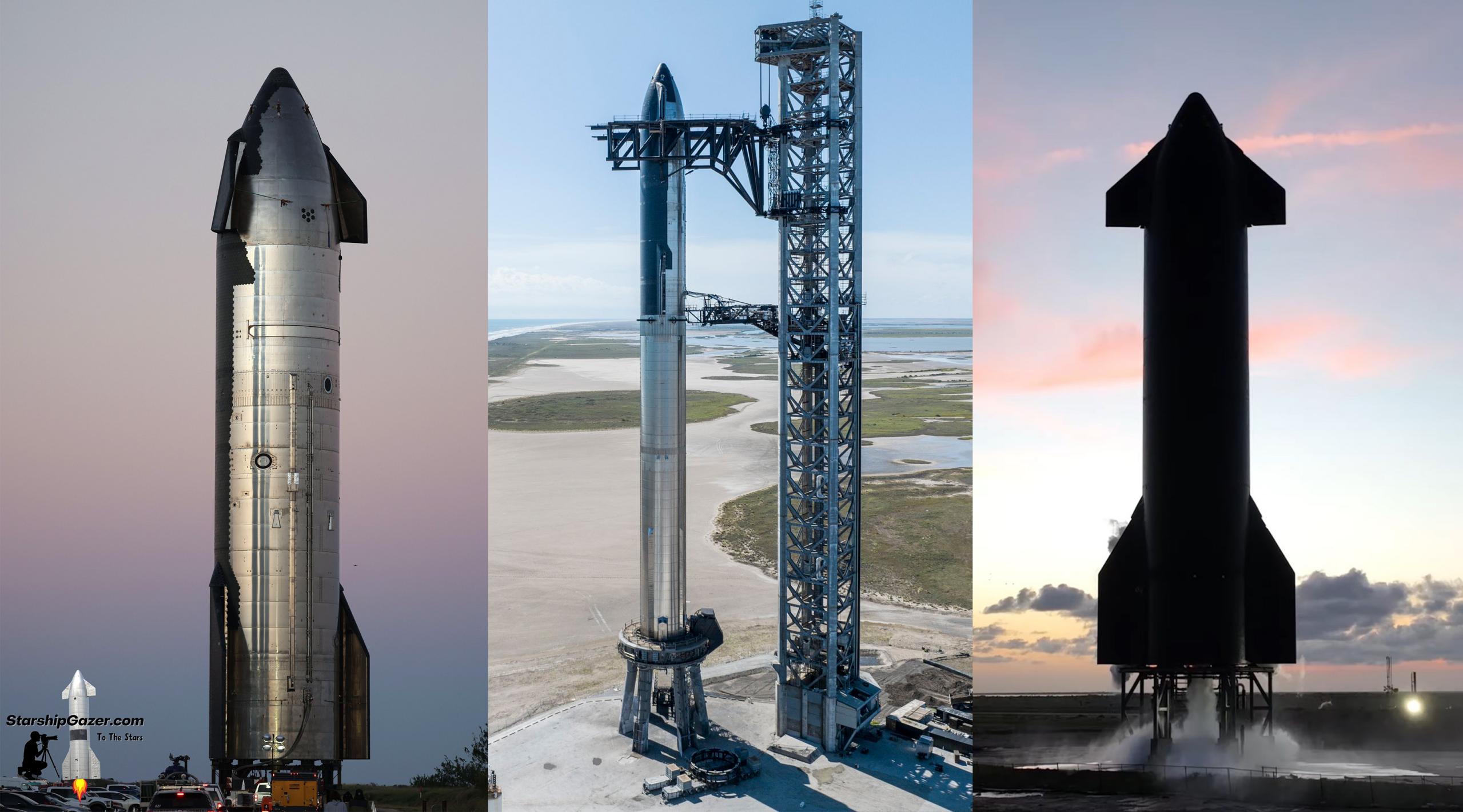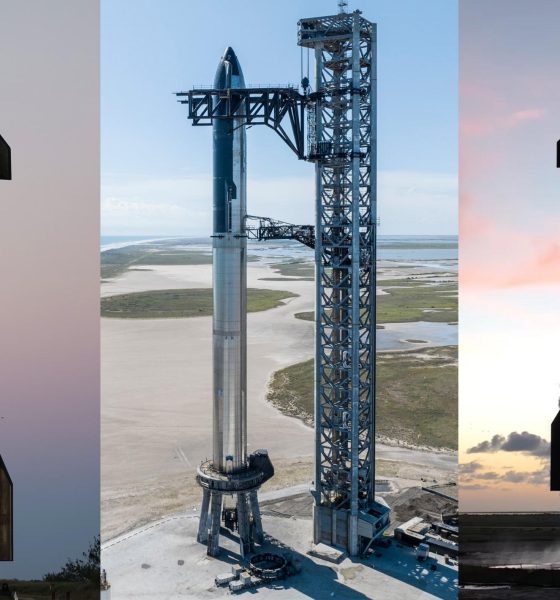

News
SpaceX shuffles Starships, gears up for more Super Heavy static fires
SpaceX is busy preparing for the orbital launch debut its next-generation Starship rocket, but the company’s South Texas rocket factory is also working around the clock to prepare several more sets of ships and boosters for the flight testing that will follow.
That was more obvious than usual on November 8th, when SpaceX made moves to prepare both of its finished Starships for new phases of testing. SpaceX kicked off the busy day by removing Starship S25 – a newer prototype that arrived at the launch site just three weeks prior – a stand dedicated to proof testing ships. Three hours later, after spending three of the last four weeks sitting on top of Super Heavy Booster 7, Starship S24 was ‘destacked’ (lifted off of B7 and lowered onto a stand on the ground) in the early afternoon.
Booster 7, Ship 24, and Ship 25 have all been busy since mid-October. SpaceX stacked Booster 7 and Ship 24 for the first time on October 11th and then attempted to test the fully-stacked rocket on October 13th. By some accounts, although almost nothing was visible to the public, the first full-stack test may have gone poorly, potentially even endangering pad technicians that approached the rocket to troubleshoot. On October 16th, SpaceX fully destacked Ship 24, and CEO Elon Musk noted that the company was “proceeding very carefully” to avoid an explosion that could set “Starship progress back by ~6 months.”
But if there was a major issue on October 13th, SpaceX didn’t show it, and Ship 24 was reinstalled atop Booster 7 on October 20th without any obvious maintenance or repairs. SpaceX then kicked off an unusual series of tests on October 24th, during which it only filled the liquid oxygen (LOx) or liquid methane (LCH4) tanks of Super Heavy B7, Ship 24, or both vehicles at once. A rare NASA briefing on October 31st later called them “single-species prop[ellant]” tests – a kind of extra-cautious testing that had never been seen before at Starbase. A few days prior, a member of NASA’s Aerospace Safety Advisory Panel (ASAP) noted that an accidental explosion that damaged Booster 7 in July had caused SpaceX to “increase [the rigor of its] systems engineering and risk management,” explaining the sudden influx of unusually conservative testing.
By the time Ship 24 was destacked from Booster 7 on November 8th, SpaceX had completed seven single-species tests, four of which involved loading LOx or LCH4 into both stages and three of which only tested Super Heavy. Booster 7 and Ship 24’s tanks were fully filled and LCH4 and LOx were never simultaneously loaded on either stage.
NASA’s October 31st briefing reported that SpaceX had plans to destack Ship 24 before conducting additional static fire testing with Booster 7. While B7 completed 1, 3, and 7-engine static fires in August and September, those tests were nowhere close to the full 33-engine static fire required to properly qualify the most powerful rocket in history. According to NASASpaceflight.com managing editor Chris Bergin, SpaceX’s next goal is to fire up approximately half of Super Heavy B7’s Raptors.
Strangely, although Ship 24 was believed to have completed all of the standalone testing needed to clear it for flight, SpaceX installed the vehicle on a stand used for Starship static fire testing on November 9th, implying that more standalone testing may be required. For now, that shouldn’t pose a problem as long as SpaceX wraps up any additional Starship testing around the same time as Booster 7’s next static fire campaign wraps up, but it could delay full-stack launch readiness if it takes any longer.
Finally, after Ship 25 was removed from SpaceX’s other Starship test stand on November 8th, it was rolled back to Starbase’s Starship factory. Ship 25 first rolled to the launch site on October 19th and has since completed four visible tests. On October 28th, Ship 25 survived a pneumatic proof test that showed that its tanks were leak-free and capable of surviving flight pressures (roughly 6-8.5 bar or 90-125 psi). Three cryogenic proof tests followed on November 1st, 2nd, and 7th. The first cryoproof was likely just that – a test that pressurized Ship 25’s tanks and filled them with cryogenic liquid nitrogen (LN2) or a combination of liquid oxygen and LN2.
The next two tests likely took advantage of the customized test stand, which has been semi-permanently outfitted with a set of hydraulic rams that allow SpaceX to simulate the thrust of six Raptor engines while Starship’s structures are chilled to cryogenic temperatures and loaded with roughly 1000 tons (~2.2M lb) of cryogenic fluids. If a Starship can survive those stresses on the ground, the assumption is that it will likely survive similar stresses in flight.
Assuming that Ship 25’s first several proof tests were successful, which they appear to have been, SpaceX returned the prototype to its Starbase factory to install six Raptor engines and a series of shields and firewalls that will protect those engines from each other. Once fully outfitted, Ship 25 will return to the launch site for static fire testing and take Ship 24’s place on Suborbital Pad B. Ship 24 took approximately two months to go from its last cryoproof to its first static fire. But its testing got off to a relatively rocky start, so Ship 25 could be ready sooner.
SpaceX could begin the next phases of Booster 7 and Ship 24 testing as early as November 10th or November 13th.

News
Tesla FSD fleet is nearing 7 billion total miles, including 2.5 billion city miles
As can be seen on Tesla’s official FSD webpage, vehicles equipped with the system have now navigated over 6.99 billion miles.

Tesla’s Full Self-Driving (Supervised) fleet is closing in on almost 7 billion total miles driven, as per data posted by the company on its official FSD webpage.
These figures hint at the massive scale of data fueling Tesla’s rapid FSD improvements, which have been quite notable as of late.
FSD mileage milestones
As can be seen on Tesla’s official FSD webpage, vehicles equipped with the system have now navigated over 6.99 billion miles. Tesla owner and avid FSD tester Whole Mars Catalog also shared a screenshot indicating that from the nearly 7 billion miles traveled by the FSD fleet, more than 2.5 billion miles were driven inside cities.
City miles are particularly valuable for complex urban scenarios like unprotected turns, pedestrian interactions, and traffic lights. This is also the difference-maker for FSD, as only complex solutions, such as Waymo’s self-driving taxis, operate similarly on inner-city streets. And even then, incidents such as the San Francisco blackouts have proven challenging for sensor-rich vehicles like Waymos.
Tesla’s data edge
Tesla has a number of advantages in the autonomous vehicle sector, one of which is the size of its fleet and the number of vehicles training FSD on real-world roads. Tesla’s nearly 7 billion FSD miles then allow the company to roll out updates that make its vehicles behave like they are being driven by experienced drivers, even if they are operating on their own.
So notable are Tesla’s improvements to FSD that NVIDIA Director of Robotics Jim Fan, after experiencing FSD v14, noted that the system is the first AI that passes what he described as a “Physical Turing Test.”
“Despite knowing exactly how robot learning works, I still find it magical watching the steering wheel turn by itself. First it feels surreal, next it becomes routine. Then, like the smartphone, taking it away actively hurts. This is how humanity gets rewired and glued to god-like technologies,” Fan wrote in a post on X.
News
Tesla starts showing how FSD will change lives in Europe
Local officials tested the system on narrow country roads and were impressed by FSD’s smooth, human-like driving, with some calling the service a game-changer for everyday life in areas that are far from urban centers.

Tesla has launched Europe’s first public shuttle service using Full Self-Driving (Supervised) in the rural Eifelkreis Bitburg-Prüm region of Germany, demonstrating how the technology can restore independence and mobility for people who struggle with limited transport options.
Local officials tested the system on narrow country roads and were impressed by FSD’s smooth, human-like driving, with some calling the service a game-changer for everyday life in areas that are far from urban centers.
Officials see real impact on rural residents
Arzfeld Mayor Johannes Kuhl and District Administrator Andreas Kruppert personally tested the Tesla shuttle service. This allowed them to see just how well FSD navigated winding lanes and rural roads confidently. Kruppert said, “Autonomous driving sounds like science fiction to many, but we simply see here that it works totally well in rural regions too.” Kuhl, for his part, also noted that FSD “feels like a very experienced driver.”
The pilot complements the area’s “Citizen Bus” program, which provides on-demand rides for elderly residents who can no longer drive themselves. Tesla Europe shared a video of a demonstration of the service, highlighting how FSD gives people their freedom back, even in places where public transport is not as prevalent.
What the Ministry for Economic Affairs and Transport says
Rhineland-Palatinate’s Minister Daniela Schmitt supported the project, praising the collaboration that made this “first of its kind in Europe” possible. As per the ministry, the rural rollout for the service shows FSD’s potential beyond major cities, and it delivers tangible benefits like grocery runs, doctor visits, and social connections for isolated residents.
“Reliable and flexible mobility is especially vital in rural areas. With the launch of a shuttle service using self-driving vehicles (FSD supervised) by Tesla in the Eifelkreis Bitburg-Prüm, an innovative pilot project is now getting underway that complements local community bus services. It is the first project of its kind in Europe.
“The result is a real gain for rural mobility: greater accessibility, more flexibility and tangible benefits for everyday life. A strong signal for innovation, cooperation and future-oriented mobility beyond urban centers,” the ministry wrote in a LinkedIn post.
News
Tesla China quietly posts Robotaxi-related job listing
Tesla China is currently seeking a Low Voltage Electrical Engineer to work on circuit board design for the company’s autonomous vehicles.

Tesla has posted a new job listing in Shanghai explicitly tied to its Robotaxi program, fueling speculation that the company is preparing to launch its dedicated autonomous ride-hailing service in China.
As noted in the listing, Tesla China is currently seeking a Low Voltage Electrical Engineer to work on circuit board design for the company’s autonomous vehicles.
Robotaxi-specific role
The listing, which was shared on social media platform X by industry watcher @tslaming, suggested that Tesla China is looking to fill the role urgently. The job listing itself specifically mentions that the person hired for the role will be working on the Low Voltage Hardware team, which would design the circuit boards that would serve as the nervous system of the Robotaxi.
Key tasks for the role, as indicated in the job listing, include collaboration with PCB layout, firmware, mechanical, program management, and validation teams, among other responsibilities. The role is based in Shanghai.
China Robotaxi launch
China represents a massive potential market for robotaxis, with its dense urban centers and supportive policies in select cities. Tesla has limited permission to roll out FSD in the country, though despite this, its vehicles have been hailed as among the best in the market when it comes to autonomous features. So far, at least, it appears that China supports Tesla’s FSD and Robotaxi rollout.
This was hinted at in November, when Tesla brought the Cybercab to the 8th China International Import Expo (CIIE) in Shanghai, marking the first time that the autonomous two-seater was brought to the Asia-Pacific region. The vehicle, despite not having a release date in China, received a significant amount of interest among the event’s attendees.








